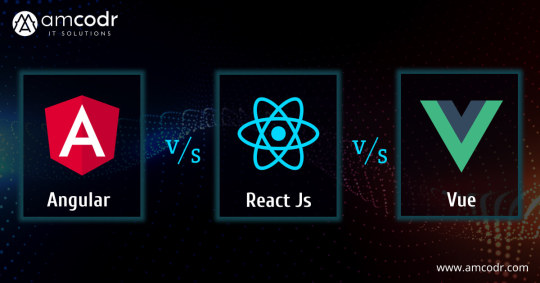#Custom ReactJS Development
Explore tagged Tumblr posts
Text
Welcome to Codeflash Infotech, your premier ReactJS development company. We specialize in harnessing the power of ReactJS to build dynamic and responsive web applications that push boundaries and exceed expectations. Our team of skilled developers leverages ReactJS's flexibility and efficiency to deliver high-performance solutions tailored to your specific business needs. Whether you're a startup, SME, or enterprise, we have the expertise to transform your ideas into reality.
0 notes
Text
Seeking Skilled React.js Developer for Innovative Projects.
Infuse the power of speed, quality, and simplicity with industry-leading developers. APPNWEB a leading mobile and web development company offers trending solutions with a perfect touch of innovation. Empower your business with enterprise-grade build quality ReactJS development solutions. We build cutting-edge digital products to create immersive experiences for end users. Our team explores…
View On WordPress
#appnweb technologies#custom reactjs development#hire reactjs developer#hire reactjs developers in india
0 notes
Text
ERP Trends 2024: Unveiling the Future of ERP Systems.
Visit Website, Glasier Inc.
Our Blogs
Other Services,
erp software development company
hospital management system
Hire Angular Developers
Hire SaaS developer
Hire Flutter Developers
Hire ReactJs Developers
#Custom ERP software development#ERP development services#ERP development#ERP software development services#ERP development Company#app development cost#app development#website#ios application development services#offshore developers#hire dedicated reactjs developers
1 note
·
View note
Text
Optimize Your Supply Chain: The Inwizards Advantage in Inventory Management Manufacturing

Struggling with supply chain inefficiencies in manufacturing? Inwizards Software Technology is here to help! Our cutting-edge inventory management solutions are designed to streamline your operations, reduce costs, and improve overall productivity. From real-time tracking to data-driven insights, we provide the tools you need to optimize every aspect of your supply chain. Experience the Inwizards advantage and transform your inventory management strategy today! Let’s build smarter solutions together.
📩 ENQUIRE NOW!
📞 USA: +971 54 508 5552 | IND: +91-96675-84436
🌐 www.inwizards.com | ✉️ [email protected]
#inwizards software technology#odoo development services#app development#odoo development company#odoo services#odoo customization#odoo customization services#odoo#reactjs development company#odoo erp solutions
0 notes
Text
Partner with the Leading ReactJS Web Development Company for Innovative Web Solutions
Partner with the leading ReactJS web development company to create innovative, scalable, high-performance web solutions tailored to your business needs.
#ReactJS web development#ReactJS development company#innovative web solutions#scalable web development#ReactJS services#custom web applications#top ReactJS developers#ReactJS development services#web application development#ReactJS experts
0 notes
Text
Modernized web application for the company in the Telecommunications and Broadcasting domain with up-to-date front-end, improved interface, and robust data visualization tools. The new system enhances operational efficiency and provides real-time insights, enabling better decision-making.
Industry: Telecom and Broadcasting Tech stack: Angular, React.js
#telecommunications#telecomsolutions#telecomindustry#telecom industry#telecom solutions#broadcasting services#outsourcing#software development#web development#staff augmentation#custom software development#it staff augmentation#custom software solutions#it staffing company#it staff offshoring#custom software#react js#reactjs#react app#angular
0 notes
Text
Corporate Website Development

LA Marketing offers corporate website development tailored to businesses of all sizes. They create professional, high-performance websites that enhance brand image, engage clients, and support business goals. Their service includes custom design, integration with business tools like CRM systems, SEO optimization, and ongoing technical support to ensure scalability and security. Whether for small businesses or large corporations, LA Marketing ensures a customized solution that reflects the company's vision.
For more details, visit:
Website: https://la-marketing.us/services/web-development/corporate-website
Facebook: https://www.facebook.com/profile.php?id=61564412960524
Linkedin: https://www.linkedin.com/company/dg-marketingcom/
X: https://x.com/foreck_info
#Los Angeles Digital Marketing Agency#E-commerce Website Development#WEB Application Development#Website Promotion#Custom Python Development Services#Corporate Website Development#ReactJS Development Services#NET Development
1 note
·
View note
Text
#website development#ai solutions#custom software development#mobile application development#ui ux design#reactjs#javascript#figma#html css#generative ai#gen ai#ai writing#llm#ai technology#artificial intelligence#seo services#web development#flutter app development#hiring#ruby on rails development company#internship#freshers#career#job
0 notes
Text

Key Things to Know About React
What is React Primarily Used For?
React is a JavaScript library created by Facebook for building user interfaces. It is widely used for developing fast, interactive web applications. React allows developers to build reusable UI components, which helps in speeding up development and enhancing the user experience.
Building Interactive Web Interfaces: React is designed to make building dynamic and responsive web interfaces simpler and more efficient.
Reusable Components: One of the core principles of React is component-based architecture. Components are self-contained modules that can be reused across different application parts, enhancing consistency and maintainability.
Virtual DOM: React uses a virtual DOM to optimize rendering performance. The virtual DOM is a lightweight copy of the actual DOM that React uses to determine the most efficient way to update the user interface.
Benefits of Using React for Software Development
Using React offers a wide range of benefits for software developers, making it a popular choice for front-end development:
Speed and Performance: React’s use of the virtual DOM and efficient diffing algorithm significantly improves performance, especially for dynamic and high-load applications.
Reusable Components: Components in React can be reused in multiple places within the application, reducing the amount of code duplication and making the development process faster and more efficient.
Large Community: React has a vast and active community. This means there are plenty of resources, tutorials, libraries, and third-party tools available to help developers solve problems and enhance their applications.
Unidirectional Data Flow: React follows a unidirectional data flow, making it easier to understand and debug applications. This structure ensures that data flows in a single direction, which can help manage the complexity of the application state.
Integration with Other Libraries and Frameworks: React can be easily integrated with other JavaScript libraries and frameworks, such as Redux for state management or Next.js for server-side rendering.
Reasons for React’s Popularity
React’s popularity in the development community can be attributed to several key factors:
Simple to Read and Easy to Use: React’s component-based architecture and JSX (JavaScript XML) syntax make it intuitive and easy to learn, even for beginners.
Designed for Easy Maintenance: The modular nature of React components simplifies the process of maintaining and updating code. Each component is isolated and can be updated independently, which reduces the risk of introducing bugs.
Robust, Interactive, and Dynamic: React excels at building highly interactive and dynamic user interfaces, making it a great choice for applications that require real-time updates and complex user interactions.
SEO-Friendly: React can be rendered on the server side using frameworks like Next.js, which improves search engine optimization (SEO) by delivering fully rendered pages to search engines.
Easy to Test: React components are easy to test, thanks to their predictable behavior and well-defined structure. Tools like Jest and Enzyme can be used to write unit tests and ensure the reliability of the codebase.
Want to Accelerate React Development at Your Company?
If you’re looking to accelerate React development at your company, we can help. Our team of experienced React developers can provide the expertise and support you need to build high-quality, performant web applications.
SEE HOW WE CAN HELP.
Contact us to find out more about our React development services and how we can support your project.
#web development#web app development#reactjs developers#reactjs#reactnative#developer#development#web development trends#web developers#custom web development
0 notes
Text
Angular vs. React vs. Vue: Which Framework Dominates in 2024?

In 2024, the battle of JavaScript frameworks continues to be dominated by Angular vs. React vs. Vue, each bringing unique strengths to front-end development. Angular, backed by Google, remains a powerhouse with its comprehensive feature set and strong enterprise support. It excels in complex, large-scale applications requiring robust architecture and TypeScript integration.
React, maintained by Facebook, retains its popularity for its flexibility and virtual DOM efficiency, making it ideal for building interactive user interfaces. Its vast ecosystem and component-based structure empower developers to create scalable applications swiftly.
Meanwhile, Vue.js, known for its simplicity and ease of integration, has steadily gained ground with its progressive framework approach. It appeals to developers seeking a lightweight yet powerful solution for building modern UIs and single-page applications.
The decision between Angular, React, and Vue hinges primarily on the specific project demands, the proficiency of the team, and the scalability requirements. While Angular suits enterprise-grade applications, React’s flexibility caters well to diverse project scopes, and Vue’s simplicity attracts startups and small teams aiming for rapid development. In 2024, these three remain the cornerstone choices in the ever-evolving landscape of front-end development.
#Angular vs. React vs. Vue#reactjs#softwaredevelopmentcompany#appdevelopment#custom application development company
0 notes
Text
Innovative React Development Services

Innovation is at the heart of our React development services. We craft interactive web applications that are both user-friendly and performance-driven.
#react web development company#reactjs development company usa#react js development company in usa#hire react js developer#react developer#custom react developer
0 notes
Text

Algoson Software is a leading machine learning and AI Product Development Company based in Mohali, India. Our team of seasoned software and AI developers is dedicated to empowering your business with cutting-edge AI solutions. By leveraging machine learning and data engineering, we transform your data into a strategic asset. Connect with us to elevate your business with Algoson’s advanced AI services. For exceptional software solutions, reach out to us at [email protected].
#leading software development company#customized software product#software development company#custom software development#software development company near me#startup software development#viewJs#reactjs#java#software developers near me#Algoson software services in Switzerland#best software development company websites#website development company#agile development services#certified java developer
0 notes
Text
Why Choose Headless Ecommerce With Shopify?
Headless ecommerce with Shopify offers unparalleled advantages for businesses seeking to elevate their online presence. By partnering with NinjaTech, clients gain access to custom ReactJS development solutions that leverage Shopify's powerful platform, delivering exceptional user experiences and driving business growth. With a focus on innovation, flexibility, and reliability, NinjaTech continues to redefine the ecommerce landscape, empowering businesses to thrive in the digital era.
#ReactJS Development Company#ReactJS Development Services#Custom ReactJS Development Solutions#Hire Dedicated ReactJS Developers#ReactJS Web Development Company
1 note
·
View note
Text
Why Inwizards is the Right Choice for Streamlining Inventory Management in Your Supply Chain

Inwizards Software Technology specializes in revolutionizing inventory management for your supply chain. Using cutting-edge technologies like AI, IoT, and real-time analytics, we help businesses minimize waste, cut costs, and enhance operational efficiency. Our tailored solutions seamlessly integrate with your systems to deliver precision and scalability. Partner with Inwizards today to streamline your supply chain, improve forecasting, and achieve a competitive edge in your industry. Ready to transform your supply chain and inventory management systems? Partner with Inwizards and unlock new levels of efficiency and growth. 📞 Call Now: 🇮🇳 +91-9667584436 | 🇦🇪 +971 54 508 5552 📧 Email: [email protected] 🌍 Visit: www.inwizards.com
#inwizards software technology#odoo customization#reactjs development company#odoo erp solutions#Software Development#Custom software#it solutions#website design#app development#web development company
0 notes
Text
The web development progress is a double-edged sword. Countless libraries and frameworks give you freedom of choice, but sometimes such a variety confuses. To help you avoid this situation when choosing a library for building a web app UI, we decided to build a data dashboard for a web application, using React, Vue.js, and Webix and comparing the results.
#outsourcing#software development#web development#staff augmentation#custom software development#it staff augmentation#custom software solutions#it staffing company#it staff offshoring#custom software#webixcustomization#webix#react js#react.js#reactjs#vuejs#vue.js
0 notes
Text

harnessing the power of ReactJS development in custom software development
#custom application development#reactjs development#hire reactjs development company#hire reactjs developers#custom software development process#implies solution
1 note
·
View note